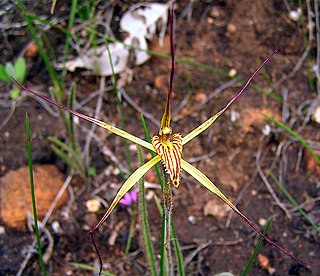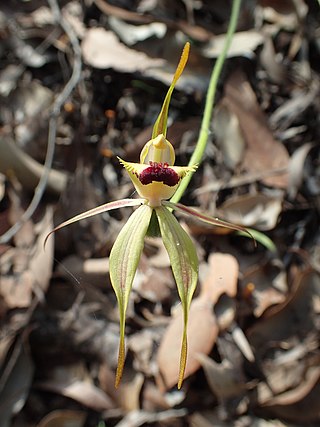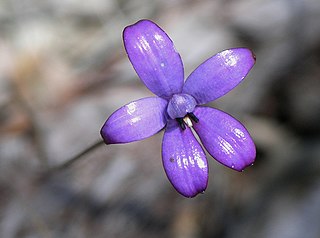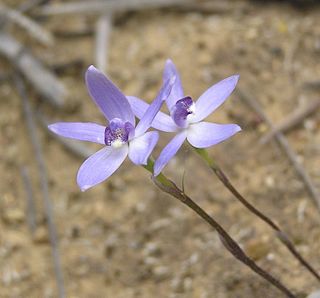Related Research Articles

Caladenia, commonly known as spider orchids, is a genus of 350 species of plants in the orchid family, Orchidaceae. Spider orchids are terrestrial herbs with a single hairy leaf and a hairy stem. The labellum is fringed or toothed in most species and there are small projections called calli on the labellum. The flowers have adaptations to attract particular species of insects for pollination. The genus is divided into three groups on the basis of flower shape, broadly, spider orchids, zebra orchids and cowslip orchids, although other common names are often used. Although they occur in other countries, most are Australian and 136 species occur in Western Australia, making it the most species-rich orchid genus in that state.
Glossodia, commonly known as waxlip orchids, is a genus of mostly purple orchids from Australia. The genus was first formally described in 1810 by the prolific Scottish botanist Robert Brown who published his description in Prodromus florae Novae Hollandiae.
Corunastylis is a historically recognized genus of about 50 species of orchids, native to Australia and New Zealand, now included in the genera Genoplesium and Prasophyllum.

Acriopsis emarginata, commonly known as the pale chandelier orchid, is a species of orchid endemic to Queensland. It is a clump-forming epiphyte with dark green leaves and curved, branching flower stems with many white and cream-coloured flowers.
Cyanicula, commonly known as blue orchids, is a genus of twelve species of plants in the orchid family, Orchidaceae. All are endemic to Australia, eleven are endemic to Western Australia and one species occurs in eastern Australia. While both the common and scientific names refer to "blue", the two subspecies of C. ixioides have yellow or white flowers. They are similar to orchids in the genus Caladenia but differ in their flowers colour and in other important ways.

Pheladenia deformis, commonly known as blue fairy orchid or blue beard is the only species of the flowering plant genus Pheladenia in the orchid family, Orchidaceae and is endemic to Australia. It was originally named as Caladenia deformis and has since had several name changes. Plants have a single, narrow, hairy leaf and usually blue flowers with relatively short, broad sepals and petals and an unusual labellum.

Caladenia latifolia, commonly known as pink fairies is a species of orchid endemic to Australia and is common and widespread in the southern half of the continent and in Tasmania. It has a single, hairy leaf and up to four pink flowers. It is easily distinguished by its relatively large, green leaf, and pink flowers on an unusually tall spike.

Caleana, commonly known as duck orchids, is a genus of flowering plants in the orchid family, Orchidaceae that is found in Australia and New Zealand. The Australian species are found in all states but have not been recorded in the Northern Territory. Duck orchids have a single leaf and one or a few, dull-coloured, inconspicuous flowers. Most species are found in Western Australia but one species occurs in eastern Australia and one occurs in eastern Australia and New Zealand. Orchids in this genus as well as the hammer orchids (Drakaea) are pollinated by male thynnid wasps.

Caladenia caesarea subsp. caesarea, commonly known as the mustard spider orchid, is a plant in the orchid family Orchidaceae and is endemic to the south-west of Western Australia. It has a single spreading, hairy leaf and up to three mustard-coloured flowers with red stripes. It was originally described as a subspecies of Caladenia filamentosa but the rich colour of its flowers and prominent labellum separate it from that species.
Caladenia caesarea subsp. transiens, commonly known as the dwarf mustard spider orchid, is a plant in the orchid family Orchidaceae and is endemic to the south-west of Western Australia. It has a single spreading, hairy leaf and up to three small lemon-yellow flowers with red stripes. It is only known from a single small population near the town of Williams.

Caladenia rhomboidiformis, commonly known as the diamond spider orchid, is a species of orchid endemic to the south-west of Western Australia. It has a single erect, hairy leaf and one or two green, yellow and red flowers. Until 1971 It was known as a variety of the green comb spider orchid Caladenia dilatata then, until 1989 as a variety of the clubbed spider orchid, Caladenia longiclavata.

Elythranthera brunonis, commonly known as the purple enamel orchid, is a plant in the orchid family Orchidaceae and is endemic to the south-west of Western Australia. It is a ground orchid with a single flattened, hairy leaf and up to three glossy purple flowers.

Cyanicula amplexans, commonly known as the dainty blue china orchid, is a plant in the orchid family Orchidaceae and is endemic to Western Australia. It has a relatively broad leaf and one or two pale blue and white flowers. It is distinguished from the other two similar blue orchids by the sides of the labellum which curve over the column and almost touch. This species also has a more inland distribution than C. aperta and C. sericea.
Caladenia subglabriphylla is a plant in the orchid family Orchidaceae and is endemic to southern Australia. It was first formally described in 2014 by Robert Bates who gave it the name Arachnorchis subglabriphylla and published the description in Australian Orchid Review. In 2015 Mark Clements changed the name to Caladenia subglabriphylla and published the change in American Journal of Botany. The specific epithet (subglabriphylla) is derived from the Latin prefix sub- meaning "somewhat" or "less than", the word glabrum meaning "hairless", "bald" or "smooth" and the Ancient Greek word phyllon meaning "leaf", hence "almost hairless leaf".

Elythranthera emarginata, commonly known as the pink enamel orchid, is a plant in the orchid family Orchidaceae and is endemic to the south-west of Western Australia. It is a ground orchid with a single flattened, hairy leaf and up to four glossy pink flowers. It is similar to Caladenia brunonis but is usually a shorter plant but with larger, pink flowers.
Caleana lyonsii, commonly known as the midget duck orchid is a species of orchid endemic to the south-west of Western Australia. It is distinguished by its single smooth narrow leaf which is usually withered by flowering time and its up to ten small, greenish flowers. It grows in harsh environments in disjunct populations between Kalbarri and Southern Cross and has the smallest flowers of its genus in Western Australia.
Enamel orchid is a common name for several plants and may refer to:

Caladenia × cala, commonly known as the wheatbelt spider orchid, is a plant in the orchid family Orchidaceae and is endemic to the south-west of Western Australia. It has a single hairy leaf and one or two red and white or greenish flowers. A natural hybrid between C.falcata and C. longicauda, it is found between Wongan Hills and Ravensthorpe.

Caladenia caesarea is a species of flowering plant in the orchid family Orchidaceae and is endemic to the south-west of Western Australia. It is a ground orchid with a single erect, hairy leaf and up to three mustard-coloured or lemon-yellow flowers.
References
- ↑ "Elythranthera brunonis". APNI. Retrieved 16 April 2017.
- ↑ "Elythranthera emarginata". APNI. Retrieved 16 April 2017.
- ↑ "Elythranthera x intermedia". APNI. Retrieved 16 April 2017.
- ↑ Clements, Mark A.; Howard, Christopher G.; Miller, Joseph T. (13 April 2015). "Caladenia revisited: Results of molecular phylogenetic analyses of Caladeniinae plastid and nuclear loci". American Journal of Botany. 102 (4): 581–597. doi: 10.3732/ajb.1500021 . PMID 25878091.
- ↑ "Elythranthera". FloraBase . Western Australian Government Department of Biodiversity, Conservation and Attractions.
- ↑ "Caladenia". Plants of the World Online. Retrieved 17 October 2023.